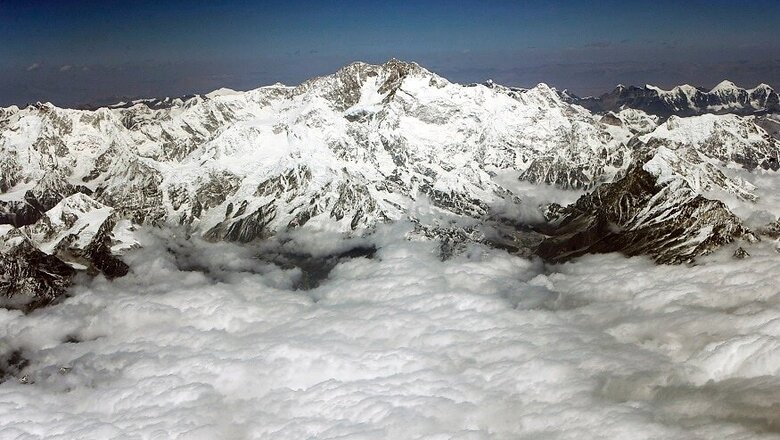
views
New Delhi: Along with being the third highest peak in the world, Mount Khangchendzonga, literally and figuratively plays an expansive role in the socio-cultural landscape of Sikkim. So intertwined it is with the lives of Sikkim’s people, that even a beautiful day is colloquially referred to as the day when one can catch a clear glimpse of the mountain.
Thus the locals urge that the Home Ministry’s order to open up Khangchendzonga and 23 other peaks in Sikkim “to foreigners desirous of mountaineering and trekking” should be seen from the perspective of the special bond that they share with this peak.
Although, the move would only stand to benefit Sikkim’s economy, here’s why it created such a hue and cry.
The hubbub over the notification
Khangchendzonga is among 14 of Sikkim’s peaks which is revered as “guardian” deity and holds a special place in Sikkim’s cultural imagination.
“We worship Khangchendzonga as a deity, we believe that Khangchendzonga is a protector,” explained Binay Gazmer. All of Sikkim’s communities including the Bhutia, Lepchas and Nepali (the three largest ethnic communities) worship the peak as a guardian deity,” the President of the Sikkim Ishai KDS Society of India said. Gazmer was among the first to raise an issue with the MHA’s order. In a letter to the Ministry, Gazmer and Amar Lohar, the society’s Vice President highlighted that the move will not only hurt the religious and cultural sentiments of people of Sikkim but is also in contravention to the Places of Worship (Special Provisions) Act.
The Act that Gazmer was referring to, was implemented in 1991 with the aim to maintain "the religious character of any place of worship". A year or so after the legislation came into force, a committee was constituted to survey and come up with a list of sacred places in the state. It named Khangchendzonga as one of the nine most “sacred Mountain Peaks of Sikkim”.
The Committee in its report recommended that the peaks “be declared as restricted,” a suggestion that was taken up by the Sikkim government, as per the 2001 notification.
“These are all protected by the Act. This is a law passed by the Parliament of India and these are all notified in Sikkim. Then how could the MHA issue such a notification permitting the scaling of this sacred peak,” rued Teshen Bhutia, convenor of the Sikkim Bhutia Lepcha Apex Community.
He added, “Either they don’t know about the places of worship or law of the land, if that is the case then it is sad since you know Sikkim is in the border state, we are surrounded by three borders and this kind of mistake can amount to a threat to our national security.”
This discontentment took a definitive turn on August 30 when a delegation led by the Chief Secretary of Sikkim, AK Srivastava, met with Union Home Secretary AK Bhalla to demand that the Ministry withdraw its notification. Three days prior to the meeting, the Sikkim government had written to the Ministry flagging the issue as a “matter of grave concern”.
So far, the Centre has only given verbal assurances to recall its order, despite the Indian Mountaineering Foundation affirming that the peak will remain closed to climbers.
"We are a small state, all of a sudden they have done it without asking us. None of the governments were consulted and they said that they have sent letters to all the governments. We can only wait for their response now” said Chief Secretary of Sikkim AK Srivastava.
The Sikkim government, he said, is onboard if 10 of 24 proposed peaks are opened up for expeditions. They have raised issues with the inclusion of the 14 “sacred” peaks, including the Khangchendzonga.
“This will definitely boost the economy, there is no doubt about that,” Gazmer quipped, “but it should not come at the cost of the people’s sentiments.”
An age-old bond in danger
Nature worship is pivotal to the religious and cultural practises of Sikkim. As filmmaker Ugyen Chopel, who is working on a travelogue on Sikkim, puts its, “Sikkim’s culture and tradition are in absolute sync with the environment”.
In fact, the biggest ethnic community, the Lepchas are known as the “children of the mountain”, have been praying to Khangchendzonga for a hundred years now. They believe that their ancestors were created from the snows of the peak’s summit. In several of their rituals, upright stones (called Long Choks), symbolic of the mountain, are used to invoke the gods and appease the spirits.
“Mount Khangchendzonga has been important throughout the history of Sikkim, it has a very important role in each and every community of Sikkim. In Buddism, Sikkim is known as Deyoul Demajong — a place that is blessed by Guru Rinpoche — and its protecting deity is Mount Khangchendzonga,” said Sangmu Thendup, an Assistant Professor in Sikkim University.
In fact, every year on the 15th day of the Tibetan calendar, people across the state come together to pray to the mountain in a festival called Pang Lhabsol.
“The government's order has hurt the people’s religious sentiment and is going to interfere with nature. There’s going to be so much pollution,” Sangmu said.
Her fears can be corroborated through studies like the one by Jagdish C. Kuniyal, a Scientist with the G.B. Pant Institute of Himalayan Environment and Development. In his paper on the Mountain expeditions: minimising the impact, Kuniyal highlights the heavy biotic pressure that expeditions have on mountains.
Expeditions, the paper notes, typically spell "grazing activities in downslope regions, waste left behind by the visitors, and emission of toxic gases from the unattended wastes." Such activities inevitably pose a threat to medicinal plants and the mountain's flora and fauna.
The mountain itself boasts of a natural reserve that is a UNESCO Heritage site. As per a report by the International Union for Conservation of Nature from 2015, the reserve has 1,580 species of vascular plants (of which 22 have been listed as endangered and 19 as threatened) and 291 species of animals including the endangered snow leopard.
For now, Sikkim’s people are still dwelling between a rock and a hard place given that the Centre is yet to give a written order.
“Unless, we get it in writing we are not going to believe them,” Tseten said.
Tseten and lakhs of people now only hope that this order comes around before the Pang Lhabsol celebrations on September 13, so little stands in the way of their mighty deity.




















Comments
0 comment